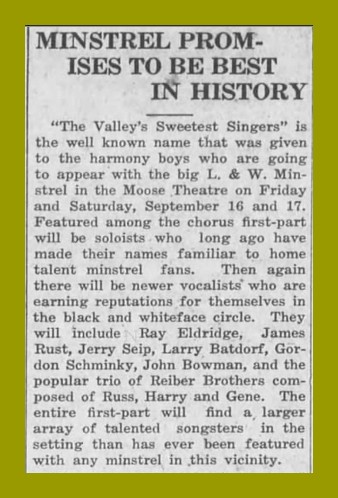An article in the Lykens Standard of September 2, 1927, promoted the upcoming show of the “L. & W. Minstrel” [Lykens & Wiconisco], which would be held at the Moose Theatre in Lykens, Dauphin County, Pennsylvania, on Friday and Saturday nights, September 16 and 17, 1927. The show featured white “entertainers” performing in black-face, and promised to be a “riot of black-face fun that crackles with laughter and comedy business.”
The show was staged at the time the Ku Klux Klan was reaching its peak of membership in the Lykens Valley area.
The L. & W. Minstrel continued to hold annual shows into the early 21st century. It is not known when they stopped using black-face in their routines.
MINSTREL PROMISES TO BE BEST IN HISTORY
“The Valley’s Sweetest Singers” is the well known name that was given to the harmony boys who are going to appear with the big L. & W. Minstrel in the Moose Theatre on Friday and Saturday, September 16 and 17 [1927]. Featured among the chorus first-part will be soloists who long ago have made their names familiar to home talent minstrel fans. Then again there will be newer vocalists who are earning reputations for themselves in the black and white-face circle. They will include: Ray Eldridge; James Rust; Jerry Seip; Larry Batdorf; Gordon Schminky; John Bowman, and the popular trio of Reiber Brothers composed of Russ Reiber, Harry Reiber, and Gene Reiber. The entire first-part will find a larger array of talented songsters in the setting than has ever been featured with any minstrel in this vicinity.
“The Merry Minstrel Mirthmakers” will present for your approval “Tommy” Flynn with his crazy rhymes and songs; “Lutz” Sholley, the flying radio man from the First Annual L. & W. Minstrel three years ago; “Ape” Spangler, the half-ton comedian who hasn’t missed one Minstrel since the first annual; and last but not least, Mr. George Hamilton Washington Slim Doneker” with his sugarfoot shuffle. These four merrymakers have collected enough laughs to make any audience hysterical, and they promise to keep the interlocutor, “Chollie” Boeckler, on the jump from the rise to the fall of the curtain. Their puns and wise cracks range all the way from Lykens politics to Loyalton bright lights. You cannot afford to miss them.
The tea garden setting of the first part will exhibit one of the most beautiful arrangements in modern minstrelsy. Orange and black will be the prevailing color scheme for the members of the chorus, while the end men will wear purple and gold costumes of Skinners’ satin. A latticed canopy will enclose the orchestra. This will be trimmed in old rose and will be decorated to blend with the colors of the rest of the setting.
Saxo-Maniacs” is the title of the first olio act. A quartette of novelty saxophonists will present a snappy program of harmony that is out of the ordinary, well-beaten path of minstrel entertainment. Their diversified presentation of song hits will be just one of the many olio attractions.
The afterpiece, entitled “The Battle of Rollin Bones” is a real appropriate American Legion riot of black-face fun that crackles with side-splitting laughter and comedy business. The scene takes place somewhere in France “before the war busted up” and from the beginning to the no time is lost by the Minstrtelites in crowding in an abundance of nonsensical humor of the overseas variety. This act is similar to the “Battle of Smoky Ham” which made such a tremendous hit with the big production three years ago, and it is hoped that this one will more than succeed the previous afterpieces in popularity.
Just think! A real Minstrel Parade will be held each evening at six o’clock. Special parade costumes have been purchased and there will be nothing left unturned in making this as flashy as “the biggest of them.” Watch for the parade! Get your tickets early! Boost the Legion! Boost the Third Annual. Let’s make L. & W. a permanent Home Talent Minstrel Organization!
White men and women, who blackened their faces, and performed emphasizing negative stereotypical behavior that they attributed to African Americans, for the purpose of getting laughs were often the most prominent people in the community.
This post is part of a series in which news articles, photographs and other “memorabilia” are presented to show how “black-face” was infused into the culture of the Lykens Valley area. Readers are invited to submit photos and recollections on how long this offensive “entertainment” lasted and what locals thought of it as part of the culture of the area.
________________________________________
News articles from Newspapers.com.
Corrections and additional information should be added as comments to this post.
